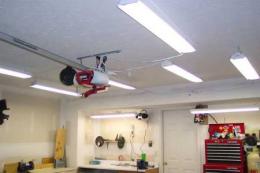Search
Login
Recommended
Brick garage, do-it-yourself garage lighting
Most often, the garage is intended not only for storing the car, but also for minor repairs and maintenance, in addition, as a rule, a small workshop is equipped in it. Moreover, sometimes a motorist has to spend several hours in a row in a garage. Naturally, the implementation of repair work will require that the lighting in the garage be made high-quality. Given the special microclimate of this room and the presence of combustible and explosive materials in it, wiring must be carried out in accordance with all safety regulations. With an eye on the cost of electricity, it will not be out of place for a garage owner to think about an efficient and energy-saving lighting option.
Content:
- How to make lighting in the garage
- Pantry area lighting
- How to choose lights for the garage
- How to calculate the wiring for a brick garage video
- Installation work videovideo
- Garage pit lighting
- Installation of distribution board
- Safety rules - must be observed!
How to make lighting in the garage
Modern garage designs usually do not provide for window openings in brick walls; such an architectural decision is made in order to ensure maximum vehicle safety. It turns out that it will be necessary to illuminate a rather large room, the installation of one central lamp in this case will be small.

To make the correct calculation of the number of fixtures, it is recommended to divide the entire area into zones. In this case, it will be possible to take into account the real requirements for each square meter of area, the lighting system created by this principle will be more functional and economical.
In practice, it is proved that lamps for a garage with a standard area of \u200b\u200b4x5 m or 3x6 m will require different:
- two of them are best installed at the entrance to the garage,
- the third is above the workshop area, optimally above the workbench,
- the fourth one can equip the territory of the mini-warehouse-pantry.
When choosing a place to place fixtures, preference should be given to walls - it is wall models that will allow you to organize high-quality lighting of the path along which the car will call.

Such lamps will need to be turned on when the car arrives in the garage, not only at night, but also during the day.

Workshop zone lighting can be equipped with one powerful ceiling lamp, but it would be more rational to include in the lighting scheme in the garage an additional lamp located directly on the wall in front of the workbench. It is advisable to provide for the possibility of its autonomous inclusion. You will need such a lamp in the case of precision work, for example, soldering wires.
Pantry area lighting
Since the shelves on the shelves can be deep enough, to facilitate the process of finding the necessary things, you can consider the option of additional lighting for each shelf. Lamps can be used for this low power.

It will be rational to perform their parallel connection. But given the peculiarity of the placement of shelves in any particular case, it will be possible to do without installing one lamp of high power on the wall or under the ceiling.
How to choose lights for the garage
Having decided on the number of necessary lighting appliances, you should think about what types of fixtures to give preference to. Typically, the choice falls on fluorescent lamps or lamps with incandescent lamps enclosed in a closed housing.

Experts do not recommend installing ordinary incandescent lamps in the garage - gasoline vapors can accumulate inside the room, their high concentration creates a risk of explosion hazard. In the case of using incandescent lamps, you will need to choose lamps made of thick glasses, the presence of additional grilles on them is mandatory!
If the budget allows, it is better to opt for more expensive halogen light sources:
- they can work for a long period,
- the brightness of the lighting created with their help is much higher.

In addition, it is recommended to use lamps with a cold glow, in a garage, it will provide better visibility. In addition, yellow light exerts more tangible pressure on the eyes. But it is only possible to use cold glow lamps in a heated room, the temperature in which does not fall below + 5 ° C; it is not recommended to use such lamps if there are constantly problems with the supply of electricity.

You can also use LED lights for the garage, at a fairly high cost, they guarantee the possibility of creating a highly functional lighting system.
How to calculate the wiring for a brick garage
Having dealt with the question of choosing luminaires and determining their exact number, you can do the calculation of wiring, i.e.:
- determine at what capacity the circuit breaker should be designed,
- determine the number of lighting circuits, usually two or three are enough for a garage (workshop, entrance, pantry),
- if it is planned to illuminate a viewing hole in a garage, or a cellar, then another, additional line will be required.
It is recommended that the circuit breaker be displayed on the main shield, and the circuit breaker should be installed at the entrance to the inspection hole.

If you follow common sense and the recommendations of safety rules, you should do three circuits, you can power them from one cable:
- copper with a cross section of 2.5 mm,
- aluminum - 4 mm.
In this case, three circuit breakers will also be required, separate for each of the circuits. Among the advantages of this option can be called a fairly high degree of security, if a fault occurs in one of the circuits, the other two will work.
Watch a video about garage lighting:
Installation work
The wiring inside the garage, just like in any other room, can be: closed, the cables in this case will be laid along the ditches in the plaster, or inside the plastic pipes, the closed wiring involves hiding the laid cables with plaster and the installation of junction boxes at the connection points of the wires .

For the garage, an open version of the wiring is a more acceptable option, it is much easier to complete it. Wiring can be done on skirting boards or use special plastic or metal boxes for it. For open type wiring, it is better to use flat cables or unarmoured protected cables. Mounting them on the walls should be done with dowels or tin brackets, the fastening step is 0, 4 m. The wiring should be done parallel to the ceiling, deviating from it 0, 2 m. The protective boxes are attached with glue or screws.
Watch a video about installing wiring:
If you plan to carry out closed wiring, it is best to lay the cable before applying the plaster. In the case of wiring in an old garage, it will be necessary to cut grooves in the plaster with a depth of 0, 5 - 0, 6 cm, lay the cables in them, fasten, then cover with plaster.

The peculiarity of such wiring is the need to solder the wires, twisting sometimes does not provide a sufficiently reliable voltage supply - the wires can unwind or lose contact as a result of surface oxidation. Repair work in this case cannot be avoided.
More clearly about how to perform the installation of hidden electrical wiring:
Garage pit lighting

As a rule, a cellar and a viewing hole in a garage are areas of high humidity. With this in mind, special safety requirements are imposed on the lighting devices that use them.
Experts recommend: to include a step-down transformer providing a voltage of 42 volts in the circuit for supplying electricity to the basement. Accordingly, the luminaires installed there must be low voltage. Working in the basement level of a garage with conventional electric lighting equipment is life threatening!
Installation of distribution board
After laying the cable, a distribution board and lighting fixtures should be installed. To install the fixtures, the fasteners included with them are used. It is advisable to install the shield with a cover; its minimum dimensions are 50x50 cm.

In this there will be enough space to accommodate all automatic machines, sockets for turning on electric tools. Dowels with 4x80 mm screws are used for attaching the shield, they are installed at the corners of the shield or at specially marked holes, the approximate distance from the fasteners to the edge of the shield is 5 cm.
Safety rules - must be observed!
The safety rules for the installation and repair of electrical wiring are as follows:
- carry out any repair and installation work only after disconnecting the voltage, i.e. by disconnecting the automatic machines, automatic plugs or unscrewing the plugs (if they are still not replaced by more modern devices) on the distribution panel,
- before starting work, you should wear a robe that gives freedom of movement,
- the tool used must be in good condition, all wires and handles must be covered with insulation, the protective covers must not be broken,
- as auxiliary means when working at heights, ladders or wooden platforms should be used, fragile tables and chairs, barrels or foam blocks should be avoided,
- you should not rush during installation work - only careful attention to the work performed can ensure the safe operation of the power supply system.

Do not forget that high-quality wiring will extend its life to 25-30 years. Problems with the network failure can occur due to laziness or carelessness, for example, due to the fact that in due time they neglected the procedure of soldering wires.
Repairing a failed system will be quite troublesome. If you have doubts about your own competence in matters of arranging power supply, it is best to turn to specialists for help.





